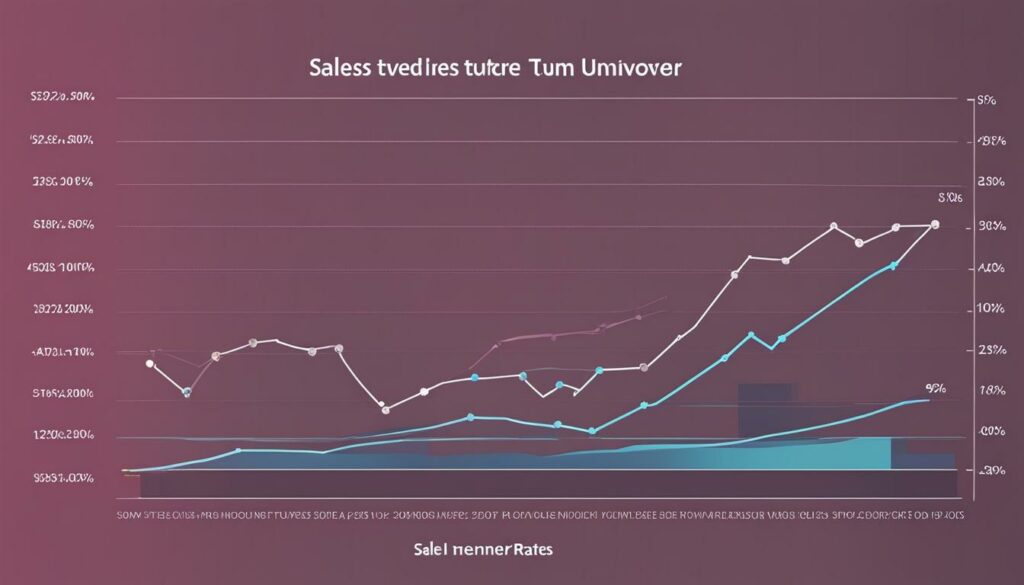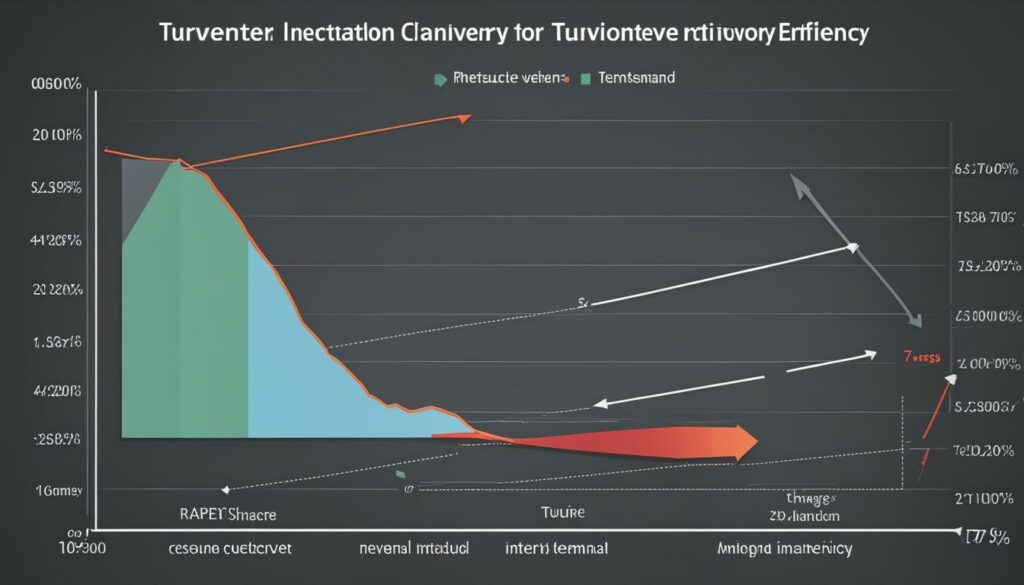Inventory turnover is a crucial aspect of efficient inventory management in the world of ecommerce. It measures the frequency with which a company sells and replenishes its inventory within a specific timeframe, providing insights into the effectiveness of its stock control and supply chain management. By calculating the inventory turnover ratio, which is obtained by dividing the sales revenue by the average inventory value, ecommerce businesses can gain valuable information about their inventory efficiency.
Key Takeaways:
- Inventory turnover is a key performance indicator for ecommerce businesses.
- It measures how quickly inventory is sold and replaced, indicating the efficiency of inventory management.
- A higher turnover ratio signifies faster movement of inventory and better stock control.
- Optimizing inventory turnover is important for maximizing cash flow and minimizing storage costs.
- Calculating the inventory turnover ratio involves dividing the sales revenue by the average inventory value.
How to Calculate Inventory Turnover
In order to measure the efficiency of inventory management in an ecommerce business, it is essential to calculate the inventory turnover ratio. The inventory turnover ratio provides valuable insights into how quickly a company sells its inventory compared to industry standards. By understanding this metric, businesses can make informed decisions regarding pricing, marketing, manufacturing, and purchasing strategies. The formula for calculating the inventory turnover ratio is:
Inventory Turnover Ratio = Sales / Average Inventory
To calculate the average inventory, you need to add the beginning inventory value and the ending inventory value, then divide the sum by 2. This calculation helps to determine the average value of inventory held during a specific period. By comparing the inventory turnover ratio with industry benchmarks, businesses can assess their inventory management performance. A higher ratio generally indicates efficient inventory management and higher sales.
Let’s consider an example to illustrate this concept. Suppose a company has sales of $1,000,000 and an average inventory value of $200,000. Using the formula, the inventory turnover ratio would be:
Inventory Turnover Ratio = $1,000,000 / $200,000 = 5
This means that the company’s inventory is turning over 5 times within the given period. Higher inventory turnover ratios suggest that the company is effectively managing its inventory and generating more sales.
Advantages of Calculating Inventory Turnover
By calculating the inventory turnover ratio, businesses can gain several advantages:
- Optimizing pricing strategies: Understanding how quickly inventory is sold can help businesses set appropriate prices for their products. If inventory turnover is slow, adjusting prices may be necessary to attract more customers and boost sales.
- Efficient manufacturing and purchasing decisions: The inventory turnover ratio provides insights into the demand for products. Businesses can use this information to streamline their manufacturing and purchasing processes, ensuring that they have the right amount of inventory to meet customer demands.
- Identifying excess inventory: A low inventory turnover ratio may indicate excess inventory, which ties up capital and increases storage costs. By monitoring the turnover ratio, businesses can identify and address excess inventory issues promptly.
- Measuring inventory efficiency: The inventory turnover ratio helps businesses evaluate the efficiency of their inventory management practices. It serves as a benchmark for comparing performance against industry standards, highlighting areas for improvement.
Calculating the inventory turnover ratio is a valuable tool for ecommerce businesses. It enables them to optimize their inventory management strategies, make informed decisions, and drive overall business success.

Importance of Inventory Turnover in Ecommerce
Inventory turnover plays a critical role in maintaining ecommerce efficiency and optimizing cash flow. For ecommerce businesses, a high inventory turnover ratio is a sign of success, indicating that inventory is being sold quickly and efficiently. This translates to a minimized capital tied up in inventory, allowing for better allocation of resources and reducing the risk of holding onto obsolete or expired products.
With a high inventory turnover ratio, ecommerce businesses can streamline their supply chain and enhance stock control strategies. By selling products at a faster rate, they can ensure that customer demands are met efficiently, resulting in higher customer satisfaction. This not only improves the overall shopping experience but also increases the chances of repeat purchases and customer loyalty.
Conversely, a low inventory turnover ratio can have negative implications for ecommerce businesses. It can lead to increased storage costs due to excess inventory occupying valuable warehouse space for extended periods. Additionally, it may indicate decreased profitability as stock lingers unsold, impacting cash flow. By monitoring and improving inventory turnover, ecommerce businesses can address these challenges and strive for efficient inventory management.
Ecommerce businesses should aim to strike a balance between maintaining optimal inventory levels and meeting customer demands. This involves accurate demand forecasting, sufficient stock replenishment, and effective order fulfillment. By doing so, businesses can avoid stockouts and overstock situations, ensuring that products are available when customers want them.
Overall, inventory turnover is a crucial metric that facilitates ecommerce efficiency, maximizes cash flow, and ensures inventory is managed effectively. By striving for higher stock turnover, businesses can optimize their operations, reduce costs, and meet customer expectations in a highly competitive market.
“Inventory turnover is the lifeblood of any ecommerce business. It not only impacts cash flow but also indicates how well the business is managing its inventory. A high turnover indicates efficiency, while a low turnover can be a red flag. It is essential to strike the right balance to ensure the smooth functioning of ecommerce operations.”
Improving Inventory Turnover in Ecommerce
Implementing the following strategies can help ecommerce businesses improve their inventory turnover:
- Accurate demand forecasting to avoid stockouts or excess inventory
- Effective order fulfillment processes to ensure timely product delivery
- Streamlining the supply chain and working with reliable suppliers
- Implementing just-in-time inventory practices to minimize holding costs
- Using sales and marketing strategies to boost product demand
By adopting these strategies and continuously analyzing inventory data, ecommerce businesses can enhance their inventory turnover, increase cash flow, and optimize their overall operations.
| Benefits of High Inventory Turnover in Ecommerce | Consequences of Low Inventory Turnover in Ecommerce |
|---|---|
| Maximized cash flow | Increased storage costs |
| Reduced risk of holding obsolete or expired products | Excess inventory occupying valuable warehouse space |
| Better allocation of resources | Decreased profitability |
| Improved customer satisfaction | Impacted cash flow |

Strategies to Improve Inventory Turnover in Ecommerce
In order to enhance inventory turnover in ecommerce, implementing a range of effective strategies is key. By optimizing various aspects of inventory management, supply chain processes, and demand forecasting, ecommerce businesses can achieve higher efficiency and profitability.
Accurate Demand Forecasting
Accurate demand forecasting plays a crucial role in inventory management. By analyzing historical data, market trends, and customer behavior, businesses can predict future demand more accurately. Adopting advanced forecasting techniques and leveraging inventory management software can help optimize inventory levels, prevent overstocking or stockouts, and improve inventory turnover.
Effective Order Fulfillment
Solid order fulfillment processes are vital for inventory turnover. Streamlining order fulfillment operations, including efficient order processing, packaging, and shipping, ensures timely delivery and customer satisfaction. By minimizing order processing time and improving order accuracy, businesses can reduce holding costs, avoid bottlenecks, and enhance inventory turnover.
Supply Chain Optimization
Streamlining the supply chain is another crucial aspect of improving inventory turnover. Partnering with reliable suppliers and implementing just-in-time (JIT) inventory practices can minimize the capital tied up in inventory and reduce storage costs. An optimized supply chain ensures the availability of the right products at the right time, leading to increased inventory turnover.
Sales and Marketing Strategies
Implementing effective sales and marketing strategies is essential to boost product demand and improve inventory turnover. Promotions, discounts, and targeted advertising campaigns can generate increased customer interest and drive sales. By creating a sense of urgency or offering limited-time offers, businesses can stimulate demand and increase inventory turnover.
Regular Data Analysis
Regular analysis of inventory data is crucial for identifying patterns, trends, and opportunities for improvement. By closely monitoring sales patterns, adjusting ordering patterns based on historical data, and optimizing stock levels, businesses can enhance inventory turnover. Data-driven decision-making allows for more efficient inventory management and improved profitability.
“Optimizing inventory turnover in ecommerce requires a holistic approach that encompasses accurate demand forecasting, efficient order fulfillment, supply chain optimization, and targeted sales and marketing strategies.”
Example: Inventory Turnover Improvement
| Before Optimization | After Optimization | |
|---|---|---|
| Inventory Turnover Ratio | 5 | 8 |
| Sales Revenue | $500,000 | $800,000 |
| Average Inventory Value | $100,000 | $100,000 |
The table above illustrates the impact of implementing inventory optimization strategies. By improving inventory turnover from 5 to 8, while keeping the average inventory value constant, sales revenue increases from $500,000 to $800,000. This demonstrates the potential financial benefits of effective inventory management.
By implementing these strategies, ecommerce businesses can achieve improved inventory turnover, reduce storage costs, enhance customer satisfaction, and ultimately drive higher profitability.
Customer Behavior and Inventory Turnover in Ecommerce
Understanding customer behavior is crucial for optimizing inventory turnover in ecommerce. By analyzing customer demand, buying patterns, and preferences, businesses can implement effective inventory control strategies to meet customer needs and improve turnover.
One key aspect of customer behavior to consider is customer demand. By closely monitoring sales data and customer feedback, ecommerce businesses can gain insights into which products are in high demand. This information can help align inventory levels with customer demand, reducing the risk of overstocking or stockouts. This ensures that customers can find the products they want, leading to increased sales and improved inventory turnover.
Buying patterns are another important factor to consider. By studying how customers make purchasing decisions, ecommerce businesses can adjust their inventory management strategies accordingly. For example, if customers tend to purchase complementary products together, businesses can bundle these items to encourage more sales. By understanding buying patterns, businesses can optimize their product offerings and increase inventory turnover.
In addition to customer demand and buying patterns, product availability is a key consideration for inventory turnover. Ecommerce brands must ensure that their online platforms reflect accurate and up-to-date stock levels. This helps to prevent situations where customers may be interested in purchasing a product but find it out of stock. By providing a seamless online shopping experience with reliable product availability, businesses can attract and retain customers, leading to increased sales and improved inventory turnover.
“Understanding customer behavior and aligning inventory levels with customer demand are essential for optimizing inventory turnover in ecommerce.”
Tracking popular products and staying informed about market trends are also crucial for improving inventory turnover. By identifying which products are in high demand and keeping a close eye on industry trends, ecommerce businesses can adjust their inventory levels accordingly. This proactive approach helps to ensure that the right products are readily available to customers, boosting sales and ultimately improving inventory turnover.
By considering customer behavior and implementing strategies to optimize inventory control, ecommerce businesses can effectively meet customer demands while improving inventory turnover. By aligning inventory levels with customer demand, tracking popular products, monitoring market trends, and ensuring reliable product availability, businesses can maximize their sales potential and achieve higher inventory turnover.

Inventory Turnover and its Relation to Other Metrics
When it comes to evaluating the financial health and efficiency of an ecommerce business, inventory turnover is closely tied to several important metrics. These metrics include the cost of goods sold (COGS), sales revenue, profitability, and return on investment (ROI). By understanding the relationship between inventory turnover and these metrics, businesses can make informed decisions and optimize their operations for better financial outcomes.
The Cost of Goods Sold (COGS)
The cost of goods sold is a crucial component in calculating the inventory turnover ratio. It represents the direct costs incurred for producing or acquiring the products that are sold to customers. By optimizing inventory turnover, businesses can reduce the cost of goods sold associated with excess inventory or slow-moving products. This not only improves the efficiency of inventory management but also helps in minimizing expenses and maximizing profitability.
Sales Revenue
Sales revenue plays a vital role in determining the effectiveness of inventory turnover. It represents the total amount of money generated from the sales of products or services over a specific period. Higher sales revenue indicates that inventory is being sold at a faster pace, leading to a higher inventory turnover ratio. By focusing on increasing sales revenue through marketing efforts, product promotions, and customer engagement strategies, businesses can stimulate demand and improve inventory turnover.
Profitability
Inventory turnover has a direct impact on profitability. By optimizing inventory turnover, businesses can effectively manage their inventory levels, reduce storage costs, and mitigate the risk of product obsolescence. These factors contribute to improved profitability by minimizing expenses associated with excess inventory and maximizing sales revenue. Higher inventory turnover reflects higher efficiency in utilizing capital and resources, resulting in increased profitability.
Return on Investment (ROI)
Return on investment is a critical metric that assesses the profitability of an investment relative to its cost. Optimizing inventory turnover can positively impact ROI by utilizing capital more efficiently. Faster inventory turnover allows businesses to free up cash that would have otherwise been tied up in inventory, making it available for other business needs. By monitoring inventory turnover and analyzing its relation to ROI, businesses can make strategic decisions to maximize their return on investment.

Monitoring inventory turnover in conjunction with other financial metrics provides a comprehensive view of the financial health and efficiency of an ecommerce business. By understanding the relationship between inventory turnover, cost of goods sold, sales revenue, profitability, and return on investment, businesses can make data-driven decisions to optimize their operations, improve financial performance, and drive sustainable growth.
Challenges and Considerations in Inventory Turnover
Inventory turnover is a critical factor for ecommerce success, but it is not without its challenges and considerations. One of the challenges is the potential for high storage costs, which can arise if inventory turnover is too low. When excess inventory remains sitting in the warehouse, it ties up valuable space and increases storage expenses. To mitigate this, ecommerce businesses need to optimize their inventory management strategies and maintain accurate inventory tracking systems to ensure the right amount of stock is available at all times.
Product obsolescence is another risk associated with inventory turnover. If inventory turnover is not managed effectively, there is an increased likelihood of products becoming obsolete before they can be sold. This can lead to financial losses and wasted resources. To prevent this, ecommerce businesses should regularly analyze market trends, customer demands, and product lifecycles to make informed decisions about inventory levels and product assortment.
Accurate inventory tracking and management systems are essential to ensure reliable data for calculating inventory turnover ratios. Without accurate data, businesses may make incorrect assumptions and decisions that can ultimately affect their profitability. By investing in robust inventory tracking systems and implementing regular auditing processes, ecommerce businesses can maintain accurate and up-to-date inventory records, allowing for more precise inventory turnover calculations and effective inventory management.
Supply chain disruptions can significantly impact inventory turnover in ecommerce. Delays or disruptions in the manufacturing or delivery process can result in stockouts or excess inventory, disrupting the smooth flow of operations and impacting customer satisfaction. To address this challenge, ecommerce businesses should have contingency plans in place, such as alternative suppliers or agile production processes, to mitigate the impact of supply chain disruptions on inventory turnover.
FAQ
What is inventory turnover in ecommerce?
Inventory turnover is a measure of how many times a company sells and replaces its inventory in a given period. It indicates the efficiency of inventory management and is crucial for maximizing cash flow and minimizing storage costs in ecommerce businesses.
How to calculate inventory turnover?
The inventory turnover ratio is calculated by dividing the sales revenue by the average inventory value. To calculate the average inventory, add the beginning inventory value and the ending inventory value, then divide by 2.
Why is inventory turnover important in ecommerce?
Inventory turnover is important in ecommerce as it indicates efficiency in inventory management, cash flow optimization, and stock control. A high inventory turnover ratio signifies faster movement of inventory and better management of stock. Conversely, a low ratio can lead to increased storage costs and decreased profitability.
What strategies can I implement to improve inventory turnover in ecommerce?
Strategies to improve inventory turnover in ecommerce include optimizing inventory management processes, streamlining the supply chain, implementing sales and marketing strategies to increase product demand, and regularly analyzing inventory data to adjust ordering patterns based on historical sales.
How does customer behavior impact inventory turnover in ecommerce?
Customer behavior plays a significant role in inventory turnover in ecommerce. By understanding customer demand, buying patterns, and preferences, businesses can align their inventory levels with customer demand, reducing the risk of excess inventory or stockouts. Tracking popular products, monitoring market trends, and providing reliable product availability contribute to increased sales and improved inventory turnover.
How is inventory turnover related to other metrics in ecommerce?
Inventory turnover is closely related to other important financial metrics in ecommerce, such as the cost of goods sold (COGS), sales revenue, profitability, and return on investment (ROI). By optimizing inventory turnover, businesses can reduce costs associated with storage and inventory maintenance, leading to higher profitability and efficient capital utilization.
What are the challenges and considerations in inventory turnover?
Challenges in inventory turnover include high storage costs if turnover is too low, the risk of product obsolescence, accurate inventory tracking and management, and supply chain disruptions. Ecommerce businesses need to address these challenges by implementing strategies to optimize inventory turnover and minimize associated risks.
